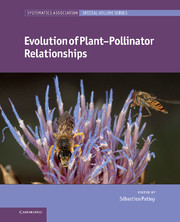Book contents
- Frontmatter
- Contents
- Contributors
- Preface
- 1 Macroevolution for plant reproductive biologists
- 2 Pollination crisis, plant sex systems, and predicting evolutionary trends in attractiveness
- 3 Evolution and ecological implications of “specialized” pollinator rewards
- 4 Fig–fig wasp mutualism: the fall of the strict cospeciation paradigm?
- 5 Fossil bees and their plant associates
- 6 Pollen evidence for the pollination biology of early flowering plants
- 7 Pollinator mediated floral divergence in the absence of pollinator shifts
- 8 Animal pollination and speciation in plants: general mechanisms and examples from the orchids
- 9 Why are floral signals complex? An outline of functional hypotheses
- 10 A survey on pollination modes in cacti and a potential key innovation
- 11 Zygomorphy, area, and the latitudinal biodiversity gradient in angiosperms
- 12 Ambophily and “super generalism” in Ceratonia siliqua (Fabaceae) pollination
- 13 Structure and dynamics of pollination networks: the past, present, and future
- 14 Pollinators as drivers of plant distribution and assemblage into communities
- 15 Effects of alien species on plant–pollinator interactions: how can native plants adapt to changing pollination regimes?
- 16 Pollen resources of non-Apis bees in southern Africa
- 17 Advances in the study of the evolution of plant–pollinator relationships
- Index
- Plate section
- References
8 - Animal pollination and speciation in plants: general mechanisms and examples from the orchids
Published online by Cambridge University Press: 05 January 2012
- Frontmatter
- Contents
- Contributors
- Preface
- 1 Macroevolution for plant reproductive biologists
- 2 Pollination crisis, plant sex systems, and predicting evolutionary trends in attractiveness
- 3 Evolution and ecological implications of “specialized” pollinator rewards
- 4 Fig–fig wasp mutualism: the fall of the strict cospeciation paradigm?
- 5 Fossil bees and their plant associates
- 6 Pollen evidence for the pollination biology of early flowering plants
- 7 Pollinator mediated floral divergence in the absence of pollinator shifts
- 8 Animal pollination and speciation in plants: general mechanisms and examples from the orchids
- 9 Why are floral signals complex? An outline of functional hypotheses
- 10 A survey on pollination modes in cacti and a potential key innovation
- 11 Zygomorphy, area, and the latitudinal biodiversity gradient in angiosperms
- 12 Ambophily and “super generalism” in Ceratonia siliqua (Fabaceae) pollination
- 13 Structure and dynamics of pollination networks: the past, present, and future
- 14 Pollinators as drivers of plant distribution and assemblage into communities
- 15 Effects of alien species on plant–pollinator interactions: how can native plants adapt to changing pollination regimes?
- 16 Pollen resources of non-Apis bees in southern Africa
- 17 Advances in the study of the evolution of plant–pollinator relationships
- Index
- Plate section
- References
Summary
Introduction
Orchids have served as a model system for pollinator-driven evolution since Darwin’s milestone contribution on the fertilization of this plant family (Darwin 1862; van der Pijl 1966; Johnson 2006; Peakall 2007). Orchids represent a major component of angiosperm diversity, and besides their famous and often highly specialized pollination systems (van der Pijl 1966; Schiestl and Schlüter 2009; Tremblay 1992), they have evolved strikingly different lifestyles and thrive in various different habitats (Dressler 1981). Many different mechanisms have been invoked as drivers for orchid-species richness (van der Pijl 1966; Dressler 1981; Peakall 2007; Gravendeel et al. 2004). For example, Cozzolino and Widmer (2005b) suggested the evolution of deceptive pollination as a key trait for orchid diversity. Another study inferred epiphytic lifestyle as a main factor for orchid diversity (Gravendeel et al. 2004). For epiphytic taxa, which indeed represent a major component of orchid diversity, a combination of fine, dust-like seeds and specialized pollination has been attributed as the key factor for species richness (Gentry and Dodson 1987). Although my review focuses on pollination and its link to species richness, it is not the purpose to advocate pollination as the main mechanism driving speciation. Rather, I aim to better clarify its role among the undoubtedly many mechanisms that shape the incredible diversity in orchids and other plants.
Despite little agreement on the definition of a species in general (Coyne and Orr 2004; Johnson 2006), most researchers acknowledge the importance of some degree of reproductive isolation between populations of incipient species (Rieseberg and Willis 2007; Grant 1981; Widmer et al. 2009). In plants, however, reproductive isolation can depend on various intrinsic and extrinsic factors that act at different levels of reproduction. For example, in two sister species of Mimulus, habitat and pollinator differences, as well as post-pollination and post-zygotic isolation work together to prevent interspecific geneflow almost totally (Ramsey et al. 2003). Early acting barriers (habitat, pollinators), however, contribute more to total isolation in this system, which is a common situation among angiosperm taxa (Rieseberg and Willis 2007; Widmer et al. 2009). Pollinator or floral isolation can be the by-product of adaptation to a pollination niche, i.e. the differential use of pollinator resources by plants (Grant 1949; Grant 1994; Johnson 2010; Levin 2004). Floral isolation can work through floral morphology (morphological isolation), allowing only certain pollinators access to rewards (e.g. through long floral spurs or tubes) or placement of pollen on different body parts of a pollinator (group). In ethological floral isolation, a specific (group of) pollinator(s) are attracted through innate preferences to given floral signals, or establishes floral constancy through learning of floral signals. Thus, floral isolation is the consequence of specialization to pollinators with specific morphology (e.g. long proboscis) or behavior (e.g. preferences for specific floral signals).
- Type
- Chapter
- Information
- Evolution of Plant-Pollinator Relationships , pp. 263 - 278Publisher: Cambridge University PressPrint publication year: 2011
References
- 2
- Cited by



